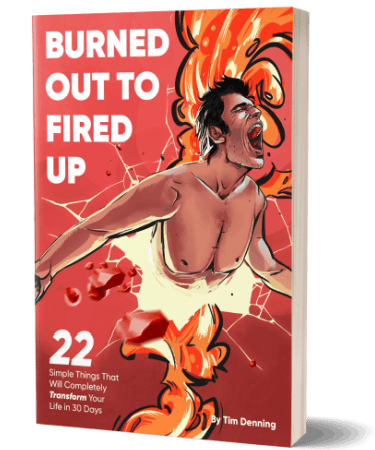“How are you?” is a lie.
Every time I hear it at the start of a conversation with a stranger, it’s rare they actually mean it. How are you? is a throwaway line we’re taught to say at a young age, so we can appear to be polite.
It’s a question that scares me. I answer it and quickly change the subject. Shallow questions we don’t mean lead us to shallow conversations. Deep conversations are how you really find out how someone is doing.
Because how are you is a surface-level question. To answer the question honestly, it requires you to show vulnerability. And we rarely wake up with Captain Planet confidence, ready to be vulnerable in front of a stranger.
How-are-you is small talk. Here’s how to go deep so you can have real conversations again.
Improvise as you go
One mistake I’ve seen in my career is executives who go too far the other way. They over-rehearse a conversation.
They try to predict what the other person is thinking. They prepare a ginormous slide deck that is too big to send via email due to the 100MB file size. The deck makes the other person want to sleep drool. Even worse is when these conversations are role-played.
Corporate role play should be banished from the world. It’s ridiculous.
The best conversations flow. They are improvised and allowed to breathe. They’re led by open-mindedness. Not knowing where a conversation is going to end up is the best feeling there is.
Maybe you’ll go home with a takeaway. Or maybe you’ll meet a person who you don’t seek to hoard, by adding their name to your phone and connecting with them on social media. That’s fine too.
A rigid pre-rehearsed conversation feels whacko. Trust yourself to have a conversation like you’ve been doing since you were a kid.
A killer question to break the ice
A good opening question is, “what are you working on?” It opens the other person up to talk about work, family, or one of their hobbies.
It’s a question that instantly points towards someone’s passions in life. When we talk about passion, we light up. That’s when the real conversation starts. I asked a woman at the local cafe the other day what she was working on while she took my order.
Turns out she went to the university next door. She’s learning subjects required to become an astronaut one day. She then went on to tell me how she likes to fly planes and see society from the skies.
To extract more insights from the conversation, I simply said “what else is involved?” Open questions allow a conversation to progress naturally, without your queries becoming a forced map a person subconsciously thinks they have to follow.
Break the tension of a conversation with “what are you working on?”
Pretend you’re not going to feature in the conversation
When I believe I’m going to play a part in a conversation, it’s hard to concentrate on what the other person is saying.
I get distracted with thinking about what I’m about to say, therefore ignoring what the other person is saying. I’m sure you can relate. When you go into a conversation and believe you won’t play a part, it changes how you show up. There’s nothing to rehearse in your head. You can listen fully and open your mind up to someone else’s experience.
Through other people’s experiences, we grow our view of the world. Conversations let us see society from another vantage point. We can see luxuries we may have been born with. We can see privileges given to us based on where we were born.
That last point is key. I feel spoilt to live in a country like Australia. It’s one of the most beautiful, friendly, clean, and safe places in the world. Many people do not live in a place like this — where every second word is mate, mate, mate.
This realization has led me to make friends with people all over the world. One of those friends lives in Nigeria. When we chat he switches on the camera for me and takes me down the main streets. The beautifully paved sidewalks with street sweepers are non-existent.
Then we talk banking. He tells me stories of families who have one member living overseas. That person sends money home each month to support the family. Unfortunately, the money is often intercepted and taken away through corruption. If the money successfully gets through, then the money-sending services charge enormous rent for the right. After that the bank can then freeze the funds or take their own secret commission.
Remove yourself from a conversation to learn about another part of the world. The benefit is far greater than showing off what you’ve been up to.
Ditch small talk for this
Obviously, there are times when you want to participate in a conversation, like a job interview. What has worked for me is replacing small talk with well thought out stories.
Storytelling explains to another person how we see the world. And how we see the world is the glue that attracts people to our journey in life.
One example I use in job interviews is a near-miss with death. I explain how when I was 16, a gang of youths stabbed my close friend and beat me to a pulp with a baseball bat.
The interviewer usually has a weird look on their face, as they’re not sure where I’m heading with the story. Then I explain to them that this horrifying experience led me to become friends with my enemy. And later, I got better at dealing with incredibly difficult situations under pressure and making friends.
Making friends became a survival mechanism.
Most of the jobs I’ve worked have had a sales element to them. Making friends is the same as building business relationships or signing partnership deals. My quirky story is a way to answer the question “how are you going to build strong work relationships?”
The components of my near-death story are:
- Vulnerability
- Facing fears
- Courage
- Friendship
- Childhood roots
- Beliefs
- Surviving under pressure
All of that from one short story. A well thought out story can communicate better than rattling off a list of skills, achievements, or people you know.
Lead with vulnerability
Podcaster Tim Ferriss explained his number one interview technique. He starts an interview — where he wishes to uncover an untold story — by being vulnerable.
This often involves him retelling his story of childhood sexual abuse, or the time where he nearly ended his own life but was saved by his library, thanks to a rogue letter they sent his mother.
Once you use vulnerability in a conversation, it creates a safe zone. All of a sudden the other person feels like they can do the same. This is where real connection happens. You start getting “I felt like that too” moments.
Don’t get me wrong, this technique doesn’t always work. But it works with the people who end up mattering.
Become an FBI agent
A lazy way to enter a conversation is to know nothing about the other person. I spend time before a conversation with a new person learning a few things about them. I google their name. I find out what town they were born in. I check to see if we have any mutual friends. Or I see if we have any mutual connections on LinkedIn.
The quickest way to build rapport is to mention a person you both know.
You can start by sharing a few experiences you’ve had with the mutual friend. This will make the other person feel like they know you, even though you’ve only just meant. Once the mutual friend is out of the conversation, you can simply find out more about them by using your research as questions.
People love talking about themselves. They love it even more when you’ve done your homework. It makes them feel special.
Belief extraction is powerful
Ask the person what they believe while you talk. Once you extract what a person believes, it tells you a lot about them.
If there’s some commonality then that can be another point which you bond over. You may also discover they’re a terrorist-worshipping psycho you want nothing to do with. Either way, beliefs can fast-track a conversation and save you time, in case you’ve accidentally attended an interview with a blood-sucking vampire or an oxygen thief.
Introverts have a secret weapon
If you identify as an introvert, it’s easy to think all these conversations tips don’t apply to you.
Introverts speak less. Introverts are quieter beings. Introverts listen more than talking. These aren’t disadvantages — they’re secret weapons.
A conversation can go a lot deeper when you sit there and truly hear what the other person is saying. Introverts can actually be the best networkers. Introverts can even go on to influence culture, like Keanu Reeves did.
Introversion is a personality trait, and a helpful one. But personality traits aren’t permanent as doctor and psychologist Benjamin Hardy discovered. You can be an introvert, extrovert, or a mix of both. They’re just labels, and labels limit our potential and make us think “not for me.”
Let your quiet tendencies enhance a conversation.
Mention the 2000 pound purple cow in the room
Not all conversations are going to be happy and worthy of the title #blessedlife.
Some conversations are going to suck. You’ll walk into the room and sit down to face your fate. It could be a divorce hearing, or a discussion about taking your children away, or a court appearance for breaking the law, or a meeting that ends in you being fired.
These difficult conversations often start with small talk, which slows down the outcome and uses up precious time. I prefer to call out the 2000 pound purple cow in the room. The dialogue speeds up with what Nicolas Cole calls “the rate of revelation.” Being upfront also shows self-awareness and a tiny display of courage.
Especially when you know you’ve done the right thing, it’s worth starting with the truth you’ve come to realize. Watching a conversation go in circles is not only boring, it’s counter-productive to reaching a conclusion.
The quicker the truth comes out the faster everybody can move on with their lives. Every day we’re slowly dying.
Don’t let hard conversations become a slow-motion horror scene from The Silence of the Lambs.
Get to the point
The bottom line is this: get to the point faster.
Writers struggle with this problem all the time. They use thousands of words that blend into a 20-minute read, to say something that could have been said beautifully in a 4-minute read. Watch Sean Kernan get to the point. Left, right, do a dance, knockout punch, conclusion. He’s brilliant at it.
The same applies in conversations. We each have a point where we switch off. If you don’t capture someone’s attention, then you may never get a chance to properly connect with them. Before you know it, they’re looking at their phone and pretending they have an incoming call, or an urgent meeting that’s about to start that they completely forgot about. Oopsie.
I learned this lesson when interviewing CEOs, cancer survivors, tv personalities, and Olympic champions earlier in my career: Getting to the point gets you a second conversation. Getting to the point can act like a subscription service you didn’t know you’d signed the other person up for.
Respect a person’s time to turn one conversation into series of conversations that could change your life.


